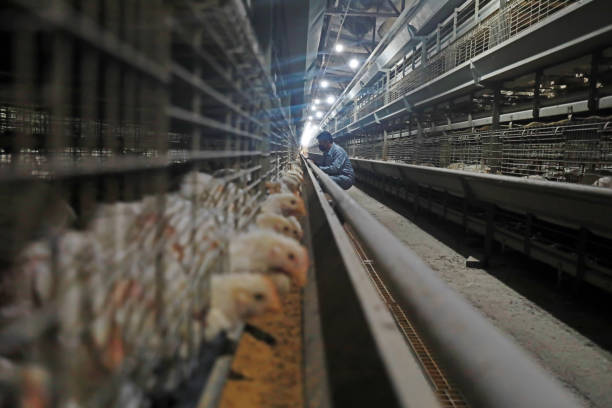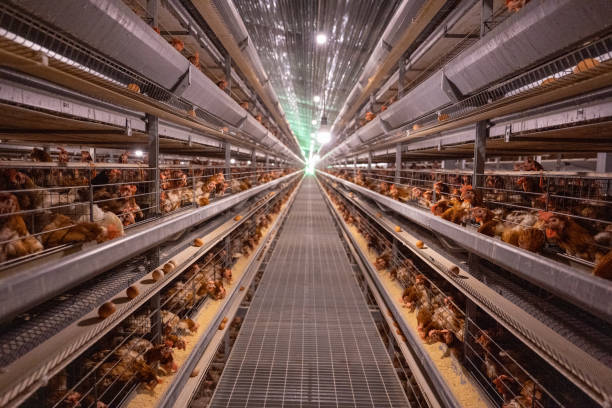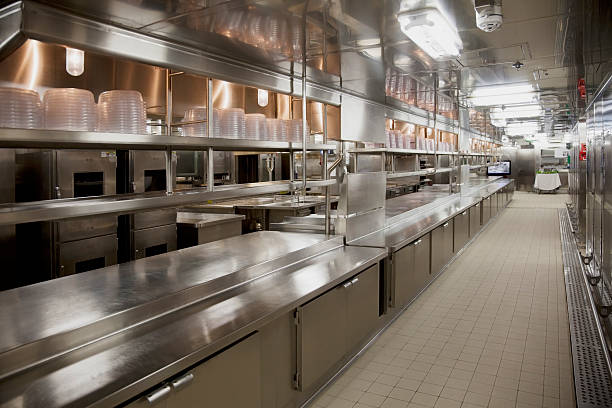Cost-Effective Layer Cages for Poultry Farms in Nigeria: Maximizing Profitability and Efficiency
Nigeria’s poultry industry is a dynamic and vital sector, contributing significantly to the nation’s food security and economy. Within this industry, egg production plays a crucial role, and the success of layer farms hinges on efficient management practices and the adoption of cost-effective technologies. Layer cages have emerged as a popular housing system, offering numerous advantages for managing large flocks and optimizing egg production. However, selecting the right type of layer cage is essential to ensure profitability and sustainability. This article explores the key considerations for choosing cost-effective layer cages for poultry farms in Nigeria, examining the benefits, types, factors influencing cost, and best practices for implementation and maintenance.
The Rise of Layer Cages in Nigerian Poultry Farming
Traditionally, poultry farming in Nigeria involved free-range or deep litter systems. While these methods have their merits, they often fall short in terms of efficiency and scalability required for modern commercial operations. Layer cages, on the other hand, offer a controlled environment that promotes better hygiene, reduces disease outbreaks, and simplifies management. The shift towards layer cages has been driven by the increasing demand for eggs and the need for farmers to maximize their output within limited space and resources.
Benefits of Using Layer Cages
Layer cages provide a wide array of advantages for poultry farmers in Nigeria:
Improved Space Utilization: Cages allow for higher stocking densities compared to floor systems, enabling farmers to house more birds in the same area, thus maximizing space utilization.
Enhanced Hygiene: Cages minimize contact between birds and their droppings, reducing the risk of disease transmission and improving overall hygiene.
Easier Management: Cages streamline management tasks such as feeding, watering, and egg collection, saving time and labor costs.
Reduced Egg Breakage: Eggs laid in cages are often cleaner and less likely to be broken, resulting in higher quality produce.

Better Monitoring: Cages facilitate individual bird monitoring, allowing farmers to identify and address health issues quickly.
Increased Egg Production: The controlled environment and optimized management practices associated with cage systems can lead to increased egg production per bird.
Predator Protection: Cages offer protection against predators, reducing losses and ensuring the safety of the flock.
Uniform Growth: Birds in cages will have a more uniform growth, which is easier for management.
Reduce Pecking: The use of cages will reduce the behavior of birds pecking each other, thus protecting the health of the birds.
Types of Layer Cages Available in Nigeria
Several types of layer cages are available in the Nigerian market, each offering different features and benefits:
A-Frame Cages: These cages are arranged in an “A” shape, with tiers stacked on top of each other. They are relatively simple in design and easy to install, making them a cost-effective option for smaller farms. Manure collection can be more challenging with A-frame cages, and usually be done manually.
H-Frame Cages: H-frame cages consist of horizontal tiers supported by vertical frames. They offer better ventilation and easier manure removal compared to A-frame cages. H-frame cages are suitable for medium to large-scale farms. The design of the H-frame cage maximizes space and efficiency.
Full Automatic Layer Cages (Battery Cages): These are the most advanced type of layer cages, incorporating automated feeding, watering, egg collection, and manure removal systems. Full automatic cages are ideal for large-scale commercial operations aiming for maximum efficiency and minimal labor input.
Semi-Automatic Layer Cages: Semi-automatic cages are semi automated layer cages which will assist the farmer in the daily running of the poultry farm.
Factors Influencing the Cost of Layer Cages
The cost of layer cages in Nigeria can vary depending on several factors:
Material: The type of material used to construct the cages significantly impacts the cost. Galvanized steel is a common choice due to its durability and resistance to corrosion. The thickness of the steel or wire mesh also affects the price.
Size and Capacity: Larger cages with higher bird capacities will naturally cost more than smaller ones. The overall size of the cage system, including the number of tiers and rows, also influences the price.
Automation Level: Automatic and semi-automatic cages, with their advanced features, are more expensive than manual cages. The cost of automation systems, such as feeding, watering, egg collection, and manure removal systems, adds to the overall expense.
Manufacturer and Brand: The reputation and brand of the cage manufacturer can affect the price. Established brands with a proven track record of quality and reliability may charge more.
Import Duties and Taxes: For imported cages, import duties and taxes can add to the overall cost, depending on the country of origin and the prevailing trade policies.
Installation Costs: The cost of installing the cages, including labor and any necessary infrastructure modifications to the poultry house, should also be considered.
Transportation Costs: Transportation cost contributes to the whole cost.
Strategies for Choosing Cost-Effective Layer Cages

To ensure profitability and sustainability of layer farms in Nigeria, the choice of layer cages should be done strategically, considering the following factors:
Assess Your Needs: Evaluate your farm’s specific requirements, including the size of your flock, available space, labor availability, and budget constraints. Understanding your needs is the first step in identifying the most cost-effective solution.
Compare Quotes from Multiple Suppliers: Obtain quotes from several reputable cage manufacturers and suppliers. Compare prices, features, and warranty conditions to make an informed decision.
Consider Local Manufacturing: Explore the possibility of purchasing cages from local manufacturers. Local manufacturers may offer competitive prices and easier access to after-sales service and spare parts.
Prioritize Quality and Durability: While cost is an important consideration, prioritize quality and durability. Investing in higher-quality cages may result in a higher initial cost but can save you money in the long run due to reduced maintenance and replacement costs.
Evaluate Automation Options: Carefully evaluate the benefits of automation based on your farm’s scale and labor costs. Automatic systems can significantly reduce labor requirements but may not be cost-effective for smaller farms.
Factor in Operational Costs: Consider the long-term operational costs associated with different cage types. Automatic systems may reduce labor costs but can increase electricity consumption and maintenance expenses.
Seek Expert Advice: Consult with experienced poultry farmers or agricultural extension officers for advice on choosing the right type of layer cages for your specific needs.
Check the Quality of the Materials: Quality is the most important thing when buying things; the better the quality, the longer they will last.
Implementation and Maintenance of Layer Cages
Proper implementation and maintenance of layer cages are essential for maximizing their lifespan and ensuring optimal performance.
Proper Installation: Follow the manufacturer’s instructions carefully when installing the cages. Ensure that the cages are properly aligned and securely fastened to the floor or support structure.
Regular Cleaning: Clean the cages regularly to remove manure and debris. This helps to maintain hygiene and prevent the buildup of harmful bacteria.
Pest Control: Implement a pest control program to prevent infestations of insects and rodents, which can damage the cages and spread diseases.
Watering System Maintenance: Inspect and maintain the watering system regularly to ensure that birds have access to fresh, clean water. Clean water troughs or nipples to prevent blockages.
Feeding System Maintenance: Inspect and maintain the feeding system regularly to ensure that birds receive adequate feed. Adjust the feed distribution system as needed to prevent feed wastage.
Ventilation: Ensure that the poultry house has adequate ventilation to remove ammonia and other harmful gases. Proper ventilation helps to maintain air quality and prevent respiratory problems in birds.
Regular Inspection: Conduct regular inspections of the cages to identify and address any signs of damage or wear. Repair or replace damaged components promptly to prevent further deterioration.
Keep Records: Maintain records of cage maintenance, repairs, and replacements. This information can help you track the performance of the cages and identify potential problems early on.
Case Studies from Nigerian Poultry Farms

Several poultry farms in Nigeria have successfully implemented cost-effective layer cage systems and achieved significant improvements in productivity and profitability. For example, a small-scale farmer in Oyo State installed A-frame cages and saw a 20% increase in egg production. A larger commercial farm in Ogun State invested in automatic layer cages and reduced labor costs by 30%. These case studies demonstrate the potential benefits of adopting layer cage systems in Nigerian poultry farming.
The Future of Layer Cages in Nigeria
The future of layer cages in Nigeria looks promising, with increasing adoption of advanced technologies and a growing focus on sustainability. As the poultry industry continues to evolve, layer cages will play a vital role in meeting the rising demand for eggs and ensuring food security. Innovations in cage design, automation, and waste management will further enhance the efficiency and sustainability of layer farms. The move towards environmentally controlled housing, which incorporates climate control and biosecurity measures, will improve bird welfare and reduce the risk of disease outbreaks.
Conclusion
Choosing the right layer cages is a crucial investment for poultry farmers in Nigeria. By carefully considering the factors discussed in this article, farmers can select cost-effective cages that maximize egg production, minimize labor costs, and promote bird health. With proper implementation and maintenance, layer cages can contribute significantly to the profitability and sustainability of poultry farms in Nigeria, helping to meet the growing demand for eggs and support the nation’s agricultural economy. Remember to prioritize quality, durability, and automation options based on your farm’s specific needs and budget constraints. The future of Nigerian poultry farming lies in adopting innovative and cost-effective technologies like layer cages to achieve greater efficiency and sustainability.






